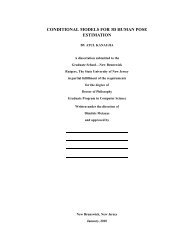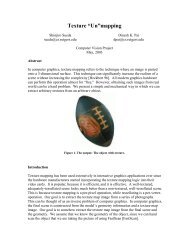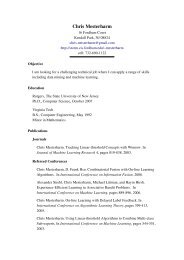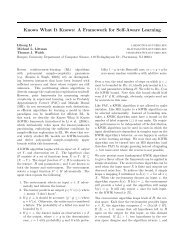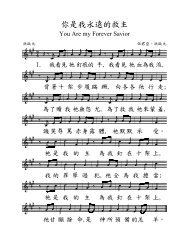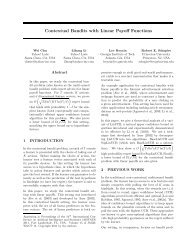Composition theorems in communication complexity
Composition theorems in communication complexity
Composition theorems in communication complexity
Create successful ePaper yourself
Turn your PDF publications into a flip-book with our unique Google optimized e-Paper software.
Let us recall the basic idea of the proof of Theorem 8. To prove a lower bound on the<br />
quantum <strong>communication</strong> <strong>complexity</strong> for a composed function f ◦ g, we constructed a witness<br />
matrix B which had non-negligible correlation with f ◦ g and small spectral norm. To do<br />
this, follow<strong>in</strong>g the work of Sherstov and Shi-Zhu [She09,SZ09b], we considered the dual<br />
polynomial p of f us<strong>in</strong>g LP duality. The dual polynomial has two important properties, first<br />
that p has non-negligible correlation with f and second that p has no support on low degree<br />
polynomials. We can then use the first property to show that the composed function p ◦ g<br />
will give non-negligible <strong>in</strong>ner product with f ◦ g and the second to upper bound the spectral<br />
norm of p ◦ g. The second of these tasks is the more difficult. In the case of G = {−1, +1} n ,<br />
the degree of a character χ T is a natural measure of how “hard” the character is — the larger<br />
T is, the smaller the spectral norm of χ T ◦ g will be. In the general group case, however, it is<br />
less clear what the correspond<strong>in</strong>g “hard” and “easy” characters should be. In Section 5.1, we<br />
will show that this framework actually works for an arbitrary partition of the basis functions<br />
<strong>in</strong>to Easy and Hard. That is for any arbitrary partition of the basis functions <strong>in</strong>to Easy and<br />
Hard sets we can follow the plan outl<strong>in</strong>ed above and look for a function with support on the<br />
Hard set which has non-negligible correlation with f.<br />
In carry<strong>in</strong>g out this plan, one is still left with upper bound<strong>in</strong>g ‖M p◦g ‖. Here, as <strong>in</strong> the<br />
Boolean case, it as aga<strong>in</strong> very convenient to have an orthogonality condition which can<br />
greatly simplify the computation of ‖M p◦g ‖ and give good bounds. In the Boolean case we<br />
have shown that M g be<strong>in</strong>g strongly balanced implies this key orthogonality condition. In<br />
Section 5.2 and 5.3, we will show that for the general group, the condition is not only about<br />
each row and column of matrix M g , but all pairs of rows and pairs of columns. In the Abelian<br />
group case, this reduces to a nice group <strong>in</strong>variance condition.<br />
Even after apply<strong>in</strong>g the orthogonality condition to use the maximum bound <strong>in</strong>stead of the<br />
triangle <strong>in</strong>equality for ‖M p◦g ‖, the rema<strong>in</strong><strong>in</strong>g term ‖M χi◦g‖ (where χ i is a “hard” character) is<br />
still not easy to upper bound. For block composed functions, fortunately, the tensor structure<br />
makes it feasible to compute. Section 5.4 gives a generalized version of Theorem 8.<br />
5.1 General framework<br />
For a multiset T , x ∈ T means x runn<strong>in</strong>g over T . Thus T = {a(s) : s ∈ S} means the multiset<br />
formed by collect<strong>in</strong>g a(s) with s runn<strong>in</strong>g over S.<br />
For a set S, denote by L C (S) the |S|-dimensional vector space over the field C (of complex<br />
numbers) consist<strong>in</strong>g of all l<strong>in</strong>ear functions from S to C, endowed with <strong>in</strong>ner product 〈ψ, φ〉 =<br />
1<br />
|S|<br />
∑<br />
s∈S ψ(s)φ(s). The distance of a function f ∈ L C(S) to a subspace Φ of L C (S), denoted<br />
by d(f, Φ), is def<strong>in</strong>ed as m<strong>in</strong>{δ : ‖f ′ − f‖ ∞ ≤ δ, f ′ ∈ Φ}, i.e. the magnitude of the least<br />
entrywise perturbation to turn f <strong>in</strong>to Φ.<br />
In the above sett<strong>in</strong>g, Theorem 8 generalizes to the follow<strong>in</strong>g.<br />
Theorem 11. Consider a sign matrix A = [f(g(x, y))] x,y where g : X × Y → S for a set S,<br />
and f : S → {−1, +1}. Suppose that we can f<strong>in</strong>d an orthogonal basis functions Ψ = {ψ i : i ∈<br />
[|S|]} for L C (S). For any hardness partition Ψ = Ψ Hard ⊎ Ψ Easy , let δ = d(f, span(Ψ Easy )).<br />
If<br />
1. (regularity) The multiset {g(x, y) : x ∈ X, y ∈ Y } is a multiple of S, i.e. S repeated for<br />
some number of times.<br />
2. (orthogonality) for all x, x ′ , y, y ′ and all dist<strong>in</strong>ct ψ i , ψ j ∈ Ψ Hard ,<br />
∑<br />
ψ i (g(x, y))ψ j (g(x ′ , y)) = ∑ ψ i (g(x, y))ψ j (g(x, y ′ )) = 0,<br />
y<br />
x<br />
then<br />
Q ɛ (A) ≥ log 2<br />
√<br />
MN · (δ − 2ɛ)<br />
max ψi∈Ψ Hard<br />
(max g |ψ i (g)| · ‖[ψ i (g(x, y))] x,y ‖) − O(1).


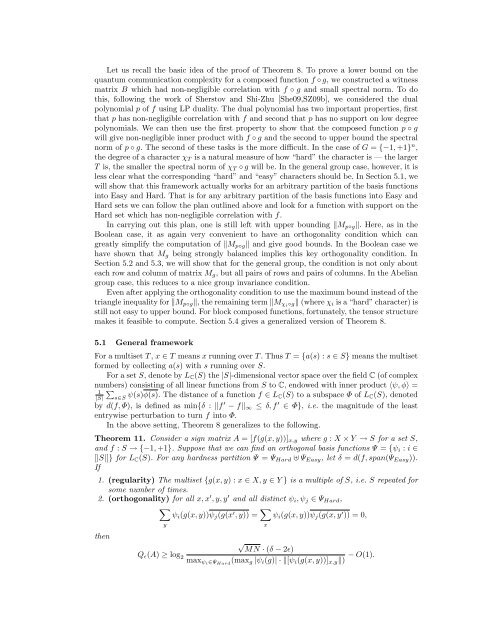
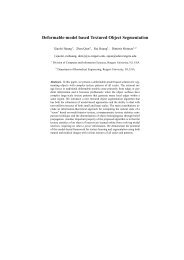
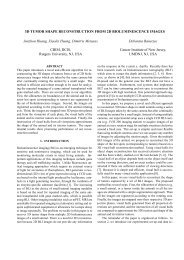
![Twitter[PDF]](https://img.yumpu.com/25710531/1/190x143/twitterpdf.jpg?quality=85)
